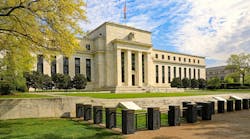The U.S. Federal Reserve voted Wednesday to hold interest rates at a 22-year high for the third straight meeting, but policymakers signaled they expect to make three rate cuts next year.
The Fed's decision to keep its key lending rate between 5.25% and 5.50% lets policymakers determine "the extent of any additional policy firming that may be appropriate," the U.S. central bank said in a statement.
The inclusion of the word "any," which was absent in November's decision, was added as "an acknowledgement that we believe that we are likely at or near the peak rate for this cycle," Fed Chair Jerome Powell told reporters.
He added that policymakers had discussed when it would be "appropriate" for the Fed to begin cutting interest rates, while refusing to rule out another hike.
Stock indexes on Wall Street surged after the Fed's decision, with the Dow Jones Industrial Average closing at an all-time high.
The Fed's stance signals a continuation of its long-running battle to slow inflation towards its long-term target of 2% amid a recent flurry of positive economic news.
"The Fed thinks that it is done with rate hikes and is more worried about overdoing it than it was in the past," KPMG Chief Economist Diane Swonk wrote in a note after the rate decision.
"After a period of nearly two years of rapid monetary policy tightening, a pivot to cuts next year seems like the most probable outcome," economists at Wells Fargo told clients.
The Fed, which has a dual mandate to tackle inflation and unemployment, is the first major central bank to unveil its interest rate decision this week.
The European Central Bank and the Bank of England will publish their own rate decisions on Thursday and are also expected to hold rates in the face of slowing inflation.
- Rate cuts ahead -
Alongside its decision on interest rates, the Fed's rate-setting Federal Open Market Committee updated its economic forecast.
FOMC members cut the median projection for interest rates at the end of next year to the midpoint between 4.50 and 4.75%, signaling they now expect 0.75 percentage points of cuts.
At 25 basis points per cut, this would translate to three rate cuts next year -- one more than most analysts were predicting going into the meeting.
The FOMC now expects the U.S. economy to grow by 2.6% this year, up from 2.1% in September, before slowing down to 1.4% in 2024.
In his press conference, Powell noted that growth appears to have slowed "substantially" in the fourth quarter of 2023 but remained on track due to strong consumer demand and improving supply conditions.
FOMC members now expect headline inflation to ease more than previously expected to 2.8% this year, and to then drop to 2.4% in 2024.
The Fed's favored inflation rate, stripping out volatile food and energy costs, is also expected to fall more quickly, while the unemployment rate remains unchanged from September's forecast.
Powell told reporters that the slowdown in the rate of price increases meant that real, inflation-adjusted wages were now rising.
"That might help to improve the mood of people," he said, nodding to the growing divide between perceptions of the U.S. economy and the reality in the data.
- Soft landing in sight -
Despite the Fed's aggressive policy of monetary tightening, growth has remained resilient, while the unemployment rate has remained close to historic lows.
The data suggests the Fed is on track for a so-called "soft landing," a rare feat in monetary policy when high interest rates bring down inflation without plunging the country into a damaging recession.
"A soft landing for the U.S. economy appears to be the most likely outcome," CFRA Chief Investment Analyst Sam Stovall wrote in an investor note.
Speaking ahead of the decision, U.S. Treasury Secretary Janet Yellen -- a former Fed chair -- said her baseline was for a soft landing.
"Monetary policy is an art and not exactly a science yet, and it requires skill and a good dose of luck to get that exactly right," she told CNBC.
Futures traders have assigned a probability of almost 85% that the Fed will prolong its pause at its next interest rate decision in January, according to CME Group Data.
Copyright 2023, Agence France-Presse




